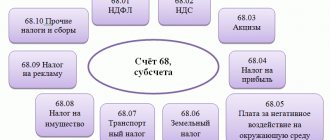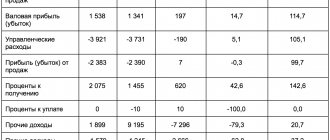Fine and penalty: what are their differences?
It should be noted that a fine and a penalty are different concepts:
- The fine is assessed immediately when the above reasons occur. In addition, its size is clearly regulated by deadlines at the legislative level.
- A penalty is a penalty payment that is charged for each day of late payment as a percentage of 1/300 of the refinancing rate of the Central Bank of the Russian Federation.
The procedure for collecting taxes and penalties from organizations:
Penalty and VAT: should tax be charged?
There are 2 opposing points of view regarding this issue:
- VAT must be charged because, in accordance with subparagraph. 2 p. 1 art. 162 of the Tax Code of the Russian Federation, the tax base for VAT is formed from any amounts that are associated with payment for goods sold (and there is no obvious reason to consider the amount of the penalty as an exception).
- There is no need to charge VAT, since the agreement on penalties in accordance with Art. 331 of the Civil Code of the Russian Federation is drawn up separately from the main agreement of the parties. Therefore, the penalty should not be associated with payment for goods (letter of the Ministry of Finance of Russia dated 06/08/2015 No. 03-07-11/33051).
If we talk about the type of penalty accrued on the basis of Art. 317.1 of the Civil Code of the Russian Federation (on interest for illegal withholding of funds), the Ministry of Finance allows VAT to be charged on the amount of such a penalty if there is a connection between it and payment for goods, without explaining the specific criteria for establishing the fact of such a connection (letter from the Ministry of Finance of Russia dated 03.08.2016 No. 03-03-06/1/45600).
Thus, the taxpayer determines whether or not to charge VAT. If there is objectively no reason to consider the penalty related to the receipt of payment for the goods, no tax is charged.
There are many types of penalties: for late payment, for downtime, for exceeding limits, etc. The Tax Guide ConsultantPlus will help you determine the calculation of VAT on the amounts of various types of penalties. You can take advantage of a free trial if you don't have K+ yet.
But if the company believes otherwise, then VAT transactions will be reflected (by the authorized party) in the accounting registers using the following entries:
- Dt 91.2 Kt 76 (sub-account “VAT”) - VAT is charged on the amount of the calculated penalty;
- Dt 76 Kt 68 - VAT is charged on the amount of the penalty received;
- Dt 68 Kt 51 - VAT on the penalty has been paid.
The penalty under the contract can be written off by the entitled party. Let's study which entries reflect this in accounting.
Displaying tax penalties in accounting
To display the costs incurred that arise when fines and penalties are calculated, account 99 Profit and loss is used. For convenience, it is divided into two subcontos - penalties and fines. The debit of this account corresponds with the corresponding tax payment, which is displayed on the credit of accounts 68 and 69.
There are opinions in accounting circles that account 91 Other expenses can also be used to display accrued penalties and fines. However, in this case, a permanent tax liability arises, which somewhat complicates the process of accounting for them.
In addition, if accrued penalties and fines are displayed on 91 accounts, this will lead to a decrease in the tax base and will violate the authenticity of the information provided in the financial indicators of the organization.
Important! Penalties and fines recognized in accounting are not reflected in tax accounting, and therefore will not reduce your tax liability in any way.
Features by count 91
Postings for the accrual of penalties also occur in account 91. But when accounting through account 91 “Other income and expenses,” the enterprise will have tax obligations, since such expenses are not accepted for taxation (clauses 4, 7 of PBU 18/02).
Contractual penalties are reflected in account 91 “Other income and expenses” (clause 7 of PBU 9/99, clause 11 of PBU 10/99). If the collection is accrued, the accounting entry is taken into account as part of other income. If paid, then the expenditure part is used.
Typical entries for the accrual and payment of fines and penalties for taxes
| Account Dt | Kt account | Transaction amount, rub. | Wiring Description | A document base |
| Accounting for fines and penalties on taxes on the account. 99 | ||||
| 99-1 | 68-4 (68-2, 68-1) | 19 000,00 | A fine was assessed for non-payment of tax (95,000.00*20%) | Buh. reference |
| 99-2 | 68-4 (68-2, 68-1) | 574,75 | A penalty has been charged for late payment of taxes. The delay was 22 days | Buh. reference |
| 68-4 (68-2, 68-1) | 51 | 19 574,75 | Payment of accrued fines and penalties for taxes | Plat. order |
| Accounting for fines and penalties on taxes on the account. 91 | ||||
| 91 | 68-4 (68-2, 68-1) | 574,75 | A penalty has been charged for late payment of taxes. The delay was 22 days | Buh. reference |
| 99-1 | 68-4 (68-2, 68-1) | 19 000,00 | A fine was assessed for non-payment of tax (95,000.00*20%) | Buh. reference |
| 68-4 (68-2, 68-1) | 51 | 19 574,75 | Payment of accrued fines and penalties for taxes | Plat. order |
| Accounting for fines and penalties on insurance premiums on the account. 99 | ||||
| 99-1 | 69 | 8 000,00 | A fine was assessed for non-payment of the insurance premium (40,000.00*20%) | Buh. reference |
| 99-2 | 69 | 275,00 | A penalty has been charged for late payment of the insurance premium. The delay was 25 days | Buh. reference |
| 69 | 51 | 8 275,00 | Payment of accrued fines and penalties on insurance premiums | Plat. order |
| Accounting for fines and penalties on insurance premiums on the account. 91 | ||||
| 91 | 69 | 275,00 | A penalty has been charged for late payment of the insurance premium. The delay was 25 days | Buh. reference |
| 99-1 | 69 | 8 000,00 | A fine was assessed for non-payment of the insurance premium (40,000.00*20%) | Buh. reference |
| 69 | 51 | 8 275,00 | Payment of accrued fines and penalties on insurance premiums | Plat. order |
| Imposition of a fine identified during an inspection | ||||
| 99 | 76 | 30 000,00 | Accrual of an administrative fine for non-use of cash registers for cash payments | Protocol |
| 76 | 51 | 30 000,00 | Payment of an administrative fine | Plat. order |
| Additional assessment of taxes and social contributions, payment of taxes and penalties | ||||
| 99 | 68-4 | 10 000,00 | Additional income tax accrual | Buh. reference |
| 90 (91) | 68-2 | 25 000,00 | Additional charge of underestimated VAT | Buh. reference |
| 20 (26, 44, 91) | 69 | 30 000,00 | Additional payment of insurance premium | Buh. reference |
| 91 (20, 26) | 68 | 15 000,00 | Additional assessment of property tax, land tax, transport tax | Buh. reference |
| If VAT is not restored | ||||
| 19 | 68-2 | 25 000,00 | Additional charge of underestimated VAT | Buh. reference |
| 91 | 19 | 25 000,00 | Inclusion of recovered VAT in expenses | Buh. reference |
| Input VAT was incorrectly accepted (reporting not signed) | ||||
| 68 | 19 | 47 000,00 | Additional VAT calculation | Buh. reference |
| 20 (26, 44, 90, 91) | 19 | 47 000,00 | Writing off input VAT on expenses | Buh. reference |
| 01 (04, 10, 41) | 19 | 47 000,00 | Inclusion of input VAT in the cost of the object | Buh. reference |
| 20 (26, 44) | 02 (05) | 7 000,00 | Additional depreciation charge for the amount of input VAT | Amor. statement |
| Input VAT was incorrectly accepted (the reporting was signed) | ||||
| 19 | 68 | 4 700,00 | Additional VAT calculation | Buh. reference |
| 91 | 19 | 4 700,00 | Writing off input VAT on expenses | Buh. reference |
| 01 (04, 10, 41) | 19 | 4 700,00 | Inclusion of input VAT in the cost of the object | Buh. reference |
| 20 (26, 44) | 02 (05) | 700,00 | Additional depreciation for the current year for the amount of input VAT | Amor. statement |
| 91 | 02 (05) | 320,00 | Additional depreciation for the past year in the amount of input VAT | Amor. statement |
How are fines (penalties) paid by the obligated party to the contract reflected in accounting?
The party to the contract, which is obliged to compensate the counterparty for losses by paying a penalty, will generate the following entries:
- Dt 91.2 Kt 76 (the penalty was recognized on the basis of a title document);
- Dt 76 Kt 51 (the penalty is transferred within the time limits specified by law or contract).
If the penalty is paid to an individual in cash, this will be reflected by the posting: Dt 76 Kt 50.
In cases provided for by law, when making settlements with an individual, not only the penalties paid - fines (penalties) are reflected in the accounting records, but also the taxes and contributions accrued on them.
So, if the recipient of the penalty is an individual who is not registered as an individual entrepreneur, then the following correspondence may additionally be drawn up:
- When the penalty arose within the framework of legal relations under an agreement, payments under which are subject to insurance premiums (for example, under a civil process agreement for the performance of work by an individual):
- Dt 76 Kt 68 (personal income tax charged for a penalty);
- Dt 68 Kt 51 (NDFL paid);
- Dt 91.2 Kt 69 (contributions are calculated for the amount of the penalty - pension and medical, in accordance with subparagraph 1, paragraph 1, article 420 of the Tax Code of the Russian Federation);
- Dt 69 Kt 51 (dues paid).
- When the penalty arose within the framework of other legal relations:
- Dt 76 Kt 68 (personal income tax charged);
- Dt 68 Kt 51 (NDFL paid).
An example of such a penalty is compensation to an individual under a shared construction agreement (letter of the Ministry of Finance of Russia dated September 15, 2017 No. 03-04-06/59629). Contributions for this type of penalty are not charged.
In both of these cases, personal income tax must be paid no later than the next day after the calculations are made (clause 6 of Article 226 of the Tax Code of the Russian Federation). Contributions, if any, are made, as usual, by the 15th day of the month following the date in which the payments were made.
Accounting for penalties in accounting
Therefore, if an organization was assessed penalties on taxes, then the accounting entry will be as follows:
Moreover, since analytical accounting for account 68 is carried out by type of tax, the credit of this account indicates the type of tax for which penalties were accrued.
So, when calculating penalties for value added tax, the posting will be as follows:
Accordingly, the transfer of the amount of accrued penalties will be reflected in the accounting entry:
And when calculating penalties for tax under the simplified tax system, the accounting entry, accordingly, will be:
Penalties for transport tax postings in accounting
The legal topic is very complex, but in this article we will try to answer the question “Penalties for transport tax transactions in accounting.”
Of course, if you still have questions, you can consult with lawyers online for free directly on the website. A company on the OSN that has violated the terms of the contract, after recognizing the penalty or in the event of a court decision, can recognize it when calculating income tax as part of non-operating expenses (clause 13, clause 1, article 265 of the Tax Code of the Russian Federation).
We take into account penalties and fines in tax accounting and prepare entries
If fines and penalties were accrued on the debit of account 99 and the credit of account 68, then in this case additional entries are not needed. The fact is that account 99 does not participate in the formation of the tax base for income tax.
Postings for accrual and payment of fines in accounting
Clause 2 of Article 270 of the Tax Code of the Russian Federation stipulates that all penalties and interest that were transferred to the budget for non-payment or late payment of taxes, contributions, and fees are not taken into account in expenses when calculating income tax.
- The fine is assessed immediately when the above reasons occur. In addition, its size is clearly regulated by deadlines at the legislative level.
- A penalty is a penalty payment that is charged for each day of late payment as a percentage of 1/300 of the refinancing rate of the Central Bank of the Russian Federation.
Accounting entries for accrual of penalties for transport tax
It is possible that the tax inspectorate violated the procedure for forced collection - according to your information, nothing like this has been seen yet. In general, the case is very unlikely to be considered in your favor.
A tax is a monetary contribution subject to mandatory payment to the federal, regional or local budget. Tax transfers are necessary to ensure the financial activities of the state.
Transport tax is one of the main sources of income for any country.
Budget classification codes according to TN
The procedure for fees from owners of cars and other vehicles is regulated by the Tax Code of the Russian Federation and documents of the regional executive authorities.
Transport tax belongs to the group of local taxes. This means that the paid contributions go to the budgets of the constituent entities of the Russian Federation.
Article 12, paragraph 1: Amnesty for individuals includes arrears: Penalties and fines relating to these taxes will also be cancelled.
: Who can be a contract manager under 44-FZ
There are opinions in accounting circles that account 91 Other expenses can also be used to display accrued penalties and fines. However, in this case, a permanent tax liability arises, which somewhat complicates the process of accounting for them.
In the course of their work, every accountant is faced with such concepts as fines and penalties, for example, when violating the laws on taxes and fees. In this article, we will study where to include tax fines in accounting, as well as the main entries for the accrual and payment of penalties, fines for taxes: profit, VAT, insurance premiums.
Typical entries for the accrual and payment of fines and penalties for taxes
- The fine is assessed immediately when the above reasons occur. In addition, its size is clearly regulated by deadlines at the legislative level.
- A penalty is a penalty payment that is charged for each day of late payment as a percentage of 1/300 of the refinancing rate of the Central Bank of the Russian Federation.
This method has the main advantage: when using 99 accounting accounts, there is no difference between the accounting data and the generated reporting. In other words, accounting account 99 is not involved in determining the size of the taxable base. Consequently, the reflection of the amounts of accrued penalties and penalties (N/P) on the account.
99 will not lead to distortion of accounting information.
For example, in accounting this term is defined as a penalty, that is, punishment for any misconduct or offense. But tax accounting does not provide for the combination of these concepts. In other words, in tax accounting these are completely different types of expenses, and it is unacceptable to take them into account in one account.
We use 99 account
Note that when calculating penalties under contracts, for example, for violation of delivery deadlines or payment for goods, works, services, these costs are reflected in 91 accounting accounts. Also, 91 accounts should be used when calculating fines from the Federal Tax Service.
When reflecting penalties in accounting, the question arises whether they can be taken into account as expenses. After all, in essence, when transferring these amounts, the organization incurs costs.
According to PBU 10/99, they are recognized as other expenses in accounting and are reflected in the debit of account 99 “Profits and losses” and the credit of accounts 68 and 69. These expenses cannot be recognized in tax accounting.
In other words, these penalties do not reduce the firm's taxable income.
Calculation of penalties for taxes - accounting entries: profit, VAT, personal income tax
The penalty is a percentage ratio of 1/300 to the refinancing rate of the Central Bank of the Russian Federation. The payer transfers the amount of penalties voluntarily or compulsorily (without the payer’s consent, the money is written off from his current account), simultaneously or after paying off debts on taxes or insurance fees.
Accounting for tax fines in accounting
Penalty or, more commonly, interest is money that is collected as a fine from the payer for late payment within the deadlines established by law. They may be charged taxes and insurance premiums.
They are calculated for each day that elapses from the date when the payment was due until the day the debt is repaid. Calculated based on the refinancing rate.
In this article we will look at the nuances of their accounting and the main entries for the calculation and payment of penalties for taxes.
: Issuance of Chernob certificates of the Bryansk region in 2021
From June 9, special fines were introduced for public sector institutions for distorting accounting and budget reporting. The President signed Law No. 113-FZ dated May 29, 2020, which amended Article 15.15.6 of the Administrative Code. The amount of the fine depends on the percentage of distortion of reporting indicators.
Responsibility for violation of budget legislation and failure to maintain accounting records
Responsibility for violation of budget legislation is most often expressed in the imposition of administrative fines, however, representatives of the Federal Treasury have the right to indisputably write off part or the entire amount of funds previously allocated by the state.
Responsibility for violation of budget legislation
According to Article 306 of the Budget Code of the Russian Federation, the decision to apply liability measures is made by the financial authority: this can be the Federal Treasury represented by the head (deputy) or the local financial authority of the subject of the Russian Federation.
Pirim LLC delayed payment of income tax in the amount of 62,000 rubles. for 15 days. The company independently calculated the penalty for violation of tax laws and transferred the tax along with the penalty. The refinancing rate at the time of calculation was 8%.
The Tax Code and PBU 10/99 regulate the issue of accrual, payment and write-off of penalties and fines for tax obligations.
When reflecting tax penalties, accounting entries can be generated using two methods. The use of each method often causes controversy in accounting circles.
The reason is the different interpretation of the concepts of “fine” and “penalty” by accounting and tax standards.
Calculation of penalties for taxes - accounting entries through 91 accounts
- D91.02 – K68 in terms of taxes when attributing penalties accrued and presented for payment to the enterprise;
- D99 – K68 for the amount of permanent tax liability (the calculated penalty is multiplied by the tax rate);
- D68 – K51 – the record is created after payment is made to the budget.
The main argument for reflecting penalties on 91 accounts is the definition of sanctions in the Tax Code, which includes the concept of “fine”. And on account 99 you can reflect tax sanctions. In income tax reporting, such amounts are combined into one category.
The opinion that the amounts of the listed penalties should be reflected in the debit of account 91 “Other expenses” and credit 68 and 69 has become widespread in accounting practice. If you take into account penalties specifically for this account, a permanent tax liability (PNO) arises, which complicates accounting.
Postings for accrual and payment of penalties for taxes: profit, VAT, personal income tax
Another “pro” in favor of accounting for penalties on account 99 is the reliability of reporting. If the amount falls on 91, the taxable profit base is underestimated, since other expenses are taken into account in expenses.
At the same time, the amounts of sanctions on account 99 do not form expenses. This does not contradict the main objective of accounting - the presentation of unconditional and genuine information about the financial performance of the organization.
The tax authorities will reflect these amounts on your personal account card based on the audit decision. Errors identified by inspectors may affect the calculation of other taxes. But inspectors are required to take these adjustments into account in the inspection report.
Posting penalties for transport tax
When using account 91 “Other income and expenses”, subaccount 2 “Other expenses”, a permanent tax liability (PNO) arises, which is calculated by multiplying the amount of tax accounted for in this account by the income tax rate (20%). PNO arises because in accounting, penalties are taken into account as expenses, but in tax accounting they are not accepted.
Tax fines and penalties: accounting and postings
In general, a penalty is charged for each calendar day of delay, starting from the day following the payment deadline until the day the arrears are repaid, inclusive. It is calculated as a percentage of the unpaid amount based on 1/300 of the refinancing rate of the Central Bank of the Russian Federation (clause 4 of Article 75 of the Tax Code of the Russian Federation).
The taxpayer must pay the late payment penalty on his own (either simultaneously with the tax or after paying it). If this is not done, the inspection will charge a penalty. And it will not only accrue, but may even forcefully collect them at the expense of the taxpayer’s money or property (clause 6 of Article 75 of the Tax Code of the Russian Federation).
The main argument for reflecting penalties on 91 accounts is the definition of sanctions in the Tax Code, which includes the concept of “fine”. And on account 99 you can reflect tax sanctions. In income tax reporting, such amounts are combined into one category.
How to record fines for tax violations and penalties for arrears
There are opinions in accounting circles that account 91 Other expenses can also be used to display accrued penalties and fines. However, in this case, a permanent tax liability arises, which somewhat complicates the process of accounting for them.
That is, the account used as a corresponding account with Dt99 (91) is Kt68 - when calculating a penalty. And when writing off amounts for transferring a sanction obligation (whether it is the simplified tax system, VAT) - Kt51. Similar postings are provided for interaction with the budget under Pension Fund sanctions on insurance premiums and Social Insurance Fund.
Accrual of penalties and fines for taxes: accounting entries
State-owned institutions, according to Instructions No. 65n, reflect their expenses for paying penalties using expense type 853 (other payments), in conjunction with Article 290 “Other” of KOSGU. Accounting for autonomous institutions is as close as possible to government and budget organizations, so the use of accounting rules here is similar.
Fine and penalty: what are their differences?
Important! There are different ways to display obligations in the general ledger, so it is better to fix the type used in the accounting policy. In both options, it is necessary to formalize the calculation of the required totals and the method for transferring them to the account. certificate
Source: https://baiksp.ru/pravo-sobstvennosti/peni-po-transportnomu-nalogu-provodki-v-buhuchete
Results
Penalties are a type of sanctions imposed on a taxpayer who delays payment of taxes to the budget. Their accrual can be reflected in accounting in one of 2 ways: through account 99 or 91. The choice of method depends on the type of tax whose payment is overdue.
Sources:
- Tax Code of the Russian Federation
- Order of the Ministry of Finance of Russia dated October 6, 2008 No. 106n
- Order of the Ministry of Finance of Russia dated May 6, 1999 No. 33n
You can find more complete information on the topic in ConsultantPlus. Free trial access to the system for 2 days.






